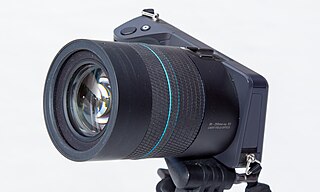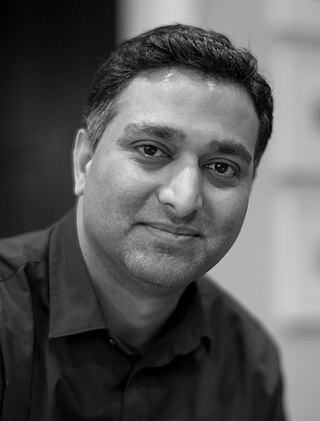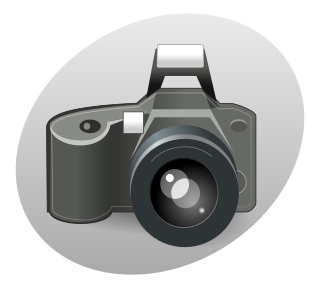
In photography, bokeh is the aesthetic quality of the blur produced in out-of-focus parts of an image, caused by Circles of Confusion. Bokeh has also been defined as "the way the lens renders out-of-focus points of light". Differences in lens aberrations and aperture shape cause very different bokeh effects. Some lens designs blur the image in a way that is pleasing to the eye, while others produce distracting or unpleasant blurring. Photographers may deliberately use a shallow focus technique to create images with prominent out-of-focus regions, accentuating their lens's bokeh.

A streak camera is an instrument for measuring the variation in a pulse of light's intensity with time. They are used to measure the pulse duration of some ultrafast laser systems and for applications such as time-resolved spectroscopy and LIDAR.
The light field is a vector function that describes the amount of light flowing in every direction through every point in space. The space of all possible light rays is given by the five-dimensional plenoptic function, and the magnitude of each ray is given by its radiance. Michael Faraday was the first to propose that light should be interpreted as a field, much like the magnetic fields on which he had been working. The phrase light field was coined by Andrey Gershun in a classic 1936 paper on the radiometric properties of light in three-dimensional space.

Computational photography refers to digital image capture and processing techniques that use digital computation instead of optical processes. Computational photography can improve the capabilities of a camera, or introduce features that were not possible at all with film based photography, or reduce the cost or size of camera elements. Examples of computational photography include in-camera computation of digital panoramas, high-dynamic-range images, and light field cameras. Light field cameras use novel optical elements to capture three dimensional scene information which can then be used to produce 3D images, enhanced depth-of-field, and selective de-focusing. Enhanced depth-of-field reduces the need for mechanical focusing systems. All of these features use computational imaging techniques.
A high-speed camera is a device capable of capturing moving images with exposures of less than 1/1,000 second or frame rates in excess of 250 fps. It is used for recording fast-moving objects as photographic images onto a storage medium. After recording, the images stored on the medium can be played back in slow motion. Early high-speed cameras used film to record the high-speed events, but were superseded by entirely electronic devices using an image sensor, recording, typically, over 1,000 fps onto DRAM, to be played back slowly to study the motion for scientific study of transient phenomena.

Non-photorealistic rendering (NPR) is an area of computer graphics that focuses on enabling a wide variety of expressive styles for digital art, in contrast to traditional computer graphics, which focuses on photorealism. NPR is inspired by other artistic modes such as painting, drawing, technical illustration, and animated cartoons. NPR has appeared in movies and video games in the form of cel-shaded animation as well as in scientific visualization, architectural illustration and experimental animation.

A light field camera, also known as a plenoptic camera, is a camera that captures information about the light field emanating from a scene; that is, the intensity of light in a scene, and also the precise direction that the light rays are traveling in space. This contrasts with conventional cameras, which record only light intensity at various wavelengths.

Autostereoscopy is any method of displaying stereoscopic images without the use of special headgear, glasses, something that affects vision, or anything for eyes on the part of the viewer. Because headgear is not required, it is also called "glasses-free 3D" or "glassesless 3D". There are two broad approaches currently used to accommodate motion parallax and wider viewing angles: eye-tracking, and multiple views so that the display does not need to sense where the viewer's eyes are located. Examples of autostereoscopic displays technology include lenticular lens, parallax barrier, and may include Integral imaging, but notably do not include volumetric display or holographic displays.

Marc Levoy is a computer graphics researcher and Professor Emeritus of Computer Science and Electrical Engineering at Stanford University, a vice president and Fellow at Adobe Inc., and a Distinguished Engineer at Google. He is noted for pioneering work in volume rendering, light fields, and computational photography.

Patrick M. Hanrahan is an American computer graphics researcher, the Canon USA Professor of Computer Science and Electrical Engineering in the Computer Graphics Laboratory at Stanford University. His research focuses on rendering algorithms, graphics processing units, as well as scientific illustration and visualization. He has received numerous awards, including the 2019 Turing Award.

Seam carving is an algorithm for content-aware image resizing, developed by Shai Avidan, of Mitsubishi Electric Research Laboratories (MERL), and Ariel Shamir, of the Interdisciplinary Center and MERL. It functions by establishing a number of seams in an image and automatically removes seams to reduce image size or inserts seams to extend it. Seam carving also allows manually defining areas in which pixels may not be modified, and features the ability to remove whole objects from photographs.
Brian A. Barsky is a professor at the University of California, Berkeley, working in computer graphics and geometric modeling as well as in optometry and vision science. He is a Professor of Computer Science and Vision Science and an Affiliate Professor of Optometry. He is also a member of the Joint Graduate Group in Bioengineering, an inter-campus program, between UC Berkeley and UC San Francisco.

A bokode is a type of data tag which holds much more information than a barcode over the same area. They were developed by a team led by Ramesh Raskar at the MIT Media Lab. Bokodes are intended to be read by any standard digital camera, focusing at infinity. With this optical setup, the tiny code appears large enough to read. Bokodes are readable from different angles and from 4 metres (13 ft) away.
A 3D display is multiscopic if it projects more than two images out into the world, unlike conventional 3D stereoscopy, which simulates a 3D scene by displaying only two different views of it, each visible to only one of the viewer's eyes. Multiscopic displays can represent the subject as viewed from a series of locations, and allow each image to be visible only from a range of eye locations narrower than the average human interocular distance of 63 mm. As a result, not only does each eye see a different image, but different pairs of images are seen from different viewing locations.

Ramesh Raskar is a Massachusetts Institute of Technology associate professor and head of the MIT Media Lab's Camera Culture research group. Previously he worked as a senior research scientist at Mitsubishi Electric Research Laboratories (MERL) during 2002 to 2008. He holds 132 patents in computer vision, computational health, sensors and imaging. He received the $500K Lemelson–MIT Prize in 2016. The prize money will be used for launching REDX.io, a group platform for co-innovation in Artificial Intelligence. He is well known for inventing EyeNetra, EyeCatra and EyeSelfie, Femto-photography and his TED talk for cameras to see around corners.
Gradient domain image processing, also called Poisson image editing, is a type of digital image processing that operates on the differences between neighboring pixels, rather than on the pixel values directly. Mathematically, an image gradient represents the derivative of an image, so the goal of gradient domain processing is to construct a new image by integrating the gradient, which requires solving Poisson's equation.
Epsilon photography is a form of computational photography wherein multiple images are captured with slightly varying camera parameters such as aperture, exposure, focus, film speed and viewpoint for the purpose of enhanced post-capture flexibility. The term was coined by Prof. Ramesh Raskar. The technique has been developed as an alternative to light field photography that requires no specialized equipment. Examples of epsilon photography include focal stack photography, High dynamic range (HDR) photography, lucky imaging, multi-image panorama stitching and confocal stereo. The common thread for all the aforementioned imaging techniques is that multiple images are captured in order to produce a composite image of higher quality, such as richer color information, wider-field of view, more accurate depth map, less noise/blur and greater resolution.

Light-in-flight imaging — a set of techniques to visualize propagation of light through different media.
Michael F. Cohen is an American computer scientist and researcher in computer graphics. He was a senior research scientist at Microsoft Research for 21 years until he joined Facebook Research in 2015. In 1998, he received the ACM SIGGRAPH CG Achievement Award for his work in developing radiosity methods for realistic image synthesis. He was elected a Fellow of the Association for Computing Machinery in 2007 for his "contributions to computer graphics and computer vision." In 2019, he received the ACM SIGGRAPH Steven A. Coons Award for Outstanding Creative Contributions to Computer Graphics for “his groundbreaking work in numerous areas of research—radiosity, motion simulation & editing, light field rendering, matting & compositing, and computational photography”.

Coded exposure photography, also known as a flutter shutter, is the name given to any mathematical algorithm that reduces the effects of motion blur in photography. The key element of the coded exposure process is the mathematical formula that affects the shutter frequency. This involves the calculation of the relationship between the photon exposure of the light sensor and the randomized code. The camera is made to take a series of snapshots with random time intervals using a simple computer, this creates a blurred image that can be reconciled into a clear image using the algorithm.













